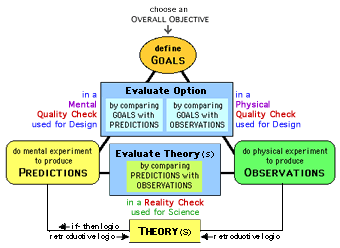Some possibilities for improving curriculum & instruction are outlined in five summaries about Using Design Process in Education and those in the page (#1, 2, 5) are good places to begin reading. Then you can click links for #3 (it's visually informative, and you can focus on whatever looks interesting) and #4 which is the most thorough, with its first 3 sections (especially "Building Bridges from Life to Design to Science to Life") being most directly relevant for K-12 science education.
Here — quoting from Building Bridges from Life to Design to Science to Life — is the reason I'm writing this page:Engineering in Science Education: Engineering is the most well-known type of design, and I'm excited (along with engineering educators) to see that the new Framework for K-12 Science Education emphasizes the importance of Scientific and Engineering Practices by including this combination as one of the 3 "dimensions" outlined on page 4 of its Executive Summary. As explained above [earlier in the section about "Building Bridges..."], using design-to-science bridges will be a useful way to help students learn the practices (the thinking-and-actions) used in engineering & science, in Engineering Design Process & Science Process.
The rest of this page explains how Design Process — which includes Science Process because science is a special type of design in which the main goals of scientists are to design experiments and explanations — could help students achieve some of the educational goals defined by the Framework for K-12 Science Education, especially those for Scientific and Engineering Practices.
TRANSFER: An explicit teaching of Science Process & Design Process can help students master the methods of thinking used in science and engineering, and it offers another valuable benefit; because we use design thinking for almost everything we do in life, a transfer of learning should occur between procedural skills learned in science and engineering, and in many other areas of life. An improved transfer-of-learning is one of the most important goals in education, and there are reasons to expect improved transfer if we use Design Process.
 Similarities and Differences
Similarities and DifferencesThe new K-12 Science Standards feature a combining of Scientific & Engineering Practices, and I'm beginning to write a page [it's the one you're now reading] to show how design experiences can help students learn some of the ideas-and-skills defined in the new standards.
Compared with other approaches to “thinking skills education” my model of Design Process is similar in many ways, which helps make it compatible with widely accepted approaches. But it's unique in some ways, offering special added value because it's more INTEGRATIVE (by showing the interactive functionally integrated relationships between different aspects of Design Process) in ways that include visually logical representations, as in this diagram that shows 3 types of comparisons used for Evaluation of Ideas by using Mental Quality Checks & Physical Quality Checks, plus the Reality Checks (Theory Checks) that are the logical foundation of science. Design Process also can be taught using a simple two-step cycle of creatively Generating Ideas and critically Evaluating Ideas, or at a deeper level by using 9 modes of thinking-and-action.
My model for Integrated Scientific Method was constructed in the context of current scholarship. This model of science was built on a solid foundation of knowledge, after I did extensive research to learn what other scholars (scientists, philosophers, historians, educators, psychologists, sociologists,...) have written about the methods of thinking that are used by scientists, as individuals and in communities.
By contrast, my construction of a model for Integrative Design Process was mainly independent from current scholarship. This model of design was built on a solid foundation of logic. I simply thought about what designers think-and-do during a process of design, analyzed their thinking-and-actions to find the functional relationships, and organized all of this into an integrative framework.
Recently, however, in November 2011 I've begun to look more closely at what others are saying about the process of design. Now I'm learning from them, and so can you. [The section continues with examples from the new Framework for K-12 Science Education, Science Buddies (comparing Design Process & Scientific Method), and the Stanford Design Program.]
Here is a very early rough-draft description of relationships between 8 "essential elements" in the Framework for K-12 Science Education and (after the "—") modes of thinking-and-action in Design Process (these modes have descriptive names, in addition to numbers you can ignore), to show that when students use Design Process (and therefore they use Science Process, because science is a special type of design) they are using almost all of the essential elements in the Framework: This relational comparison can be done in two ways — • as above where I'm showing how parts of Design Process use the essential elements, or • by showing the elements that are used while using the 9 modes of Design Method — and I'll develop both types of comparison. • This page also will include other comparisons & analyses, including Figure 3.1 (on the 3rd page of Chapter 3) in terms of Design Process, and much more.
|